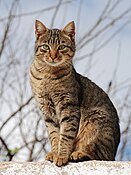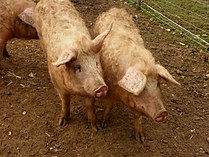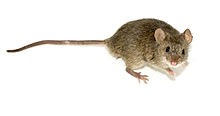Pseudopregnancy
In mammalian species,pseudopregnancyis a physical state whereby all the signs and symptoms of pregnancy are exhibited,[1]with the exception of the presence of afetus,creating a false pregnancy. Thecorpus luteum(the remains of an ovulatedovarian follicle) is responsible for the development of maternal behavior andlactation,which are mediated by the continued production ofprogesteroneby the corpus luteum through some or all of pregnancy. In most species, the corpus luteum is degraded in the absence of a pregnancy. However, in some species, the corpus luteum may persist in the absence of pregnancy and cause "pseudopregnancy", in which the female will exhibit clinical signs of pregnancy.[2]
The mechanism is not well understood, butprolactinand its receptors are known to be involved in pseudopregnancy.[3]The role of prolactin in maintaining pseudopregnancy is evident. For instance in the rodent, if chronic prolactin is administered the pseudopregnancy will continue, whereas the condition only lasts a few days if not administered.[4]
Cats
[edit]Pseudopregnancy occurs when a female catovulatesbut is notfertiliseddue to breeding with an infertile male, spontaneous ovulation or due to the owner stimulating ovulation. Thecorpus luteumis present after ovulation and persists for around 37 days. The length of pseudopregnancy varies greatly with the mean duration being 41 days. After pseudopregnancy, the female cat returns toproestrusand can become pregnant again. The pseudopregnancy lasts around half the length of a normal pregnancy in cats. This is advantageous to cats as they can conceive earlier making them more efficient in reproduction.[5]

Catsbecome pseudopregnant following an estrus in which thequeenis bred by an infertile male. Queens areinduced ovulators,meaning that they will only ovulate and produce a corpus luteum if they are bred. The corpus luteum persists as if the queen were pregnant because the queen's body cannot distinguish between the pregnant and non-pregnant state (aside from the initial mechanical trigger of coitus). Pseudopregnant queens rarely show any mammary enlargement or behavioral signs and therefore rarely require treatment. Pseudopregnancy in cats is uncommon as the queen must be bred by aninfertilemale to become pseudopregnant, compounded by the fact that cats are seasonal breeders.[6]
Theprogesteroneandestradiolprofiles in pseudopregnancy are very different when compared to normal pregnancy. During pseudopregnancy, estradiol increases straight after mating and then decreases to normal levels. The amount of progesterone does not increase until 2–3 days post copulation, then the level rises until day 21 post copulation where after it gradually declines to normal levels.[5]
Dogs
[edit]Pseudopregnancy is a normal physiologic process that occurs in femaledogs.It is seen 45–60 days after a normalestrous(heat) period. After ovulation, progesterone levels rise. Pseudopregnancy happens when the progesterone levels begin to fall as decreasing progesterone leads to an increase of the hormoneprolactin.Prolactin is responsible for the behaviours seen during pseudopregnancy. Dogs may exhibit mothering of toys, nesting or aggression. Mammary development and milk production are common. Pseudopregnancy can also be acutely induced byspaying(removing ofovaries) a dog near the end of estrus. Spaying removes the source of progesterone and induces a rise in prolactin.
Permanent prevention of pseudopregnancy is accomplished with spaying.[7]

Dogsbecome pseudopregnant following anestrusphase in which the female dog is not bred, or in which she is bred by an infertile male. Most species require signals from an embryo (such asIFN-τinruminants) to alert the female's body of a pregnancy. This maternal recognition of pregnancy will cause persistence of the corpus luteum and the development of characteristics and behaviors necessary to care for offspring. Recent research suggests that progesterone secretion is similar in pregnant and non-pregnant female dogs,[8]so veterinary researchers hypothesize that they may not require molecular factors from the embryo for maternal recognition of pregnancy, and instead the corpus luteum persists regardless of pregnancy. Since the corpus luteum is not degraded, it will cause the development of maternal characteristics in the absence of pregnancy. Pseudopregnant dogs will develop theirmammary glands,lactate,and buildneststo varying degrees depending on breed. Although female dogs usually only cycle once or twice per year, pseudopregnancy is common.[9]
Swine
[edit]Pseudopregnancy or "not-in-pig" is a condition that occurs when females exhibit physiological and behavioral signs associated with pregnancy, but there are no fetuses present. Pseudopregnancy can occur when all of theembryos are resorbedafter the maternal recognition of pregnancy (days 10–15 postmating) and before fetal bone calcification (days 35–40 of gestation). The sow remains inanoestrusfor prolonged periods, often as long as 115 days. These animals may exhibit varying degrees ofudderdevelopment, but fail to deliver any pigs. The timely identification and removal of non-pregnant females from the breeding herd is important because it reduces both non-productive sow days and production costs.[10]

Techniques used for pregnancy diagnosis in swine includeultrasonography,amplitude depthmachines, andDoppler machines.[11]
Mycotoxinshave been shown to be detrimental to sows and gilts by causing the female to retain acorpora luteainhibiting cyclicity and causing a pseudopregnancy; as well as a constant exhibition of estrus, and infertility. Pregnant females produce litters that result in a higher number of stillborns, mummified fetuses, and abortions. Before breeding, ingesting mycotoxins mimics the action of estradiol-17β. Specifically,zearalenonebinds to estrogenic receptors that would normally bind to estrogen, causing the female to exhibit constant estrus.[12]
Rats
[edit]The initiation of pseudopregnancy is basically similar to the pregnancy regarding the activation of progestational state. The neuroendocrine pathway of pseudopregnancy in rats is mainly initiated by thenocturnalsurge of prolactin.[13]The hormone prolactin produced regulates the activation and early maintenance of corpus luteum. The corpus luteum is known as a site of progesterone production in order for the uterus undergoes adecidualprocess. There are two types of induced pseudopregnancy; coitally induced pseudopregnancy and non-coitally induced pseudopregnancy.[14]

The coitally induced pseudopregnancy is stimulated by the action of copulation. The copulation stimulation causes the nocturnal prolactin elevation which then activates the corpus luteum. The multiple intromission coital pattern initiates the neuroendocrine reflex which results in the sufficient progesterone secretion in pseudopregnancy. However, induction of pseudopregnancy requiresadrenergic systemto be activated and simultaneously inhibits thecholinergic system.[14]
The non-coitally induced pseudopregnancy requires the presence of the initial stimulus until the levels of progesterone are sufficiently elevated to produce positive feedback on secretion of prolactin. The initial stimulus can be in a form of some socio-environmental factors, such as concaveation with foster pups in virgin rats orcohabitationin all-female groups in mice.[14]
Mice
[edit]
Micebecome pseudopregnant following an estrus in which the female is bred by an infertile male, resulting in sterile mating.[15]Like dogs, mice arespontaneous ovulators.However, they will not become pseudopregnant following an estrus in which the female does not mate because the corpus luteum will degrade rapidly in the absence ofcoitus.When the female is mated by an infertile male, the corpus luteum persists without an embryo, leading to pseudopregnancy. The female will developmammary glands,lactate,and build nests in the pseudopregnant state. Pseudopregnancy in mice is somewhat common inlaboratory micebecause it is often induced for the purpose ofimplanting embryosinto asurrogate dam,but is uncommon in wild mice because most wild males are fertile and will genuinely impregnate the female.[2]
References
[edit]- ^Yadav T, Balhara YP, Kataria DK (January 2012)."Pseudocyesis Versus Delusion of Pregnancy: Differential Diagnoses to be Kept in Mind".Indian Journal of Psychological Medicine.34(1): 82–84.doi:10.4103/0253-7176.96167.PMC3361851.PMID22661815.
- ^abCunningham JG, Klein BG (2007).Textbook of Veterinary Physiology(Fourth ed.). St. Louis: Elsevier Inc.
- ^Foster RA (January 2017). "Female reproductive system and mammae.". In Zachary JF (ed.).Pathologic basis of veterinary disease(6th ed.). Mosby. pp. 1147–1193.doi:10.1016/B978-0-323-35775-3.00018-7.ISBN978-0-323-35775-3.
- ^Demirel MA, Suntar I, Ceribaşı S, Zengin G, Ceribaşı AO (2018-08-01). "Evaluation of the therapeutic effects of Artemisia absinthium L. on pseudopregnancy model in rats".Phytochemistry Reviews.17(4): 937–946.Bibcode:2018PChRv..17..937D.doi:10.1007/s11101-018-9571-3.ISSN1572-980X.S2CID254948383.
- ^abPetersen A (2015)."Reproductive physiology of the female cat".Epsilon Archive for Student Projects.
- ^Tsutsui T, Stabenfeldt GH (1993). "Biology of ovarian cycles, pregnancy and pseudopregnancy in the domestic cat".Journal of Reproduction and Fertility. Supplement.47(47): 29–35.PMID8229938.
- ^Larsen J."Canine pseudopregnancy"(PDF).UC Davis School of Veterinary Medicine. Archived fromthe original(PDF)on 5 June 2015.Retrieved2017-10-13.
- ^Hinderer J, Lüdeke J, Riege L, Haimerl P, Bartel A, Kohn B, et al. (November 2021)."Progesterone Concentrations during Canine Pregnancy".Animals.11(12): 3369.doi:10.3390/ani11123369.PMC8697939.PMID34944146.
- ^Gobello C, Concannon PW, Verstegen J (August 2001)."Canine pseudopregnancy: a review."(PDF).In Concannon PW, England G, Verstegen J (eds.).Recent advances in Small animal reproduction.Ithaca, New York: International Veterinary Information Service. Archived fromthe original(PDF)on April 19, 2011.
- ^Flowers WL (2001)."Real-time ultrasonography and diagnosis of pseudopregnancy in swine".NC State University.Retrieved2017-10-13.
- ^Flowers WL, Knox RV."Pregnancy diagnosis in swine"(PDF).Pork Information Gateway. Archived fromthe original(PDF)on 2017-11-17.Retrieved2017-10-13.
- ^Diekman MA, Green ML (May 1992)."Mycotoxins and reproduction in domestic livestock".Journal of Animal Science.70(5): 1615–1627.doi:10.2527/1992.7051615x.PMID1388147.
- ^Terkel J (1988). "Neuroendocrine processes in the establishment of pregnancy and pseudopregnancy in rats".Psychoneuroendocrinology.13(1–2): 5–28.doi:10.1016/0306-4530(88)90004-2.PMID3287417.S2CID12881334.
- ^abcTerkel J (1986). "Neuroendocrinology of coitally and noncoitally induced pseudopregnancy".Annals of the New York Academy of Sciences.474(1): 76–94.Bibcode:1986NYASA.474...76T.doi:10.1111/j.1749-6632.1986.tb28000.x.PMID3555247.S2CID41857353.
- ^Pritchett KR, Taft RA (2007)."Reproductive biology of the laboratory mouse: Pseudopregnancy".In Fox JG, Barthold S, Davisson M, Newcomer CE, Quimby FW, Smith A (eds.).The Mouse in Biomedical Research: history, wild mice, and genetics.Vol. III (2nd ed.). Boston: Academic Press. p. 103.doi:10.1016/B978-012369454-6/50057-1.ISBN978-0-12-369457-7.
Further reading
[edit]- Canine Pregnancy and Pseudopregnancyat Louisiana State University School of Veterinary Medicine
